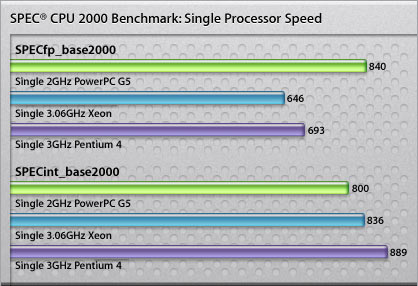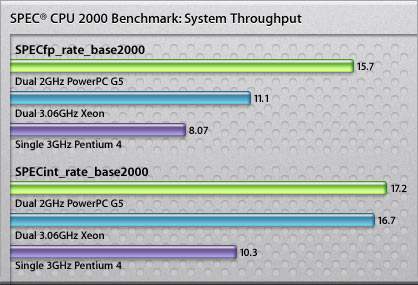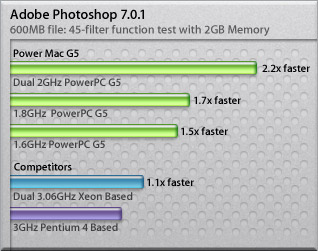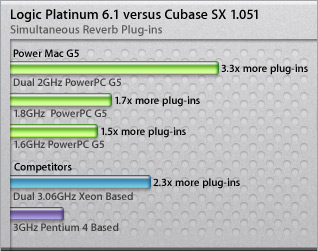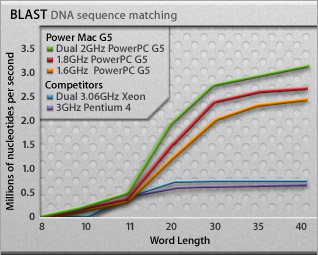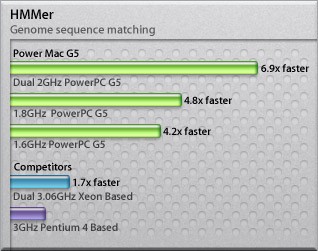
| The PowerPC G5
out-shoots the Pentium 4 in a battery of tests. But it’s in the
rough-and-tumble of real-world performance that the G5 really comes
into its own — shredding the PC’s reputation in the process. |
|||
|
|||
The Power Mac G5 delivers a significant performance leap that will delight design and publishing professionals. More system memory and a faster memory architecture let you manipulate massive image files and layouts entirely in RAM, thus reducing the need for the G5 to keep accessing the hard drive while you perform these actions. And other hardware features — like integrated Gigabit Ethernet, DVD burning and fast Serial ATA hard drives — put design and print workflows on a very fast track. It helps that the Power Mac G5 comes with Mac OS X, the world’s most powerful operating system. With so many graphics-friendly technologies and attributes, Mac OS X thrives in a studio environment. ColorSync, for instance, ensures consistent, accurate color. AppleScript makes it easy to manage repetitive tasks consistently across your workflow. And a palette of elegant typestyles with powerful font management features built in gives you the tools you need for cutting-edge design. What’s more, Mac OS X’s multitasking and memory management strengths let you work in more applications than ever before. Apple ran the Adobe Photoshop tests using a 600MB Photoshop file and a suite of 45 commonly used Photoshop actions, including file saving, image adjustments, mode changes, and filters. We measured the time to execute each filter or function and compared the performance of all actions using an indexed score. The files were stored entirely in RAM, making this a good test of each system’s processor and memory bandwidth capabilities. To demonstrate the superiority of the Power Mac G5, Apple conducted tests using Adobe Photoshop, the most popular application among creative professionals. Photoshop is an effective cross-platform measure of system performance because it has been optimized for both Macintosh and Windows platforms. It even takes advantage of the latest processor technologies on both platforms: SSE2 in the Pentium 4 and the Xeon, and Velocity Engine in the PowerPC G5. |
|||
The Power Mac G5 supports more audio tracks with real-time effects and more software instruments than any previous desktop system in history, giving audio pros a wealth of creative resources in a native environment. In addition, Mac OS X Core Audio offers a scalable platform that supports 32-bit high-resolution audio, a single plug-in called Audio Units for DSP and software Instruments, and plug-and-play connectivity for modern and legacy audio gear. And the built-in optical S/PDIF connects to other audio equipment for pristine sound quality — without those pesky ground loops. To quantify the performance advantages of the Power Mac G5 for audio production, Apple tested two of the industry leaders in professional audio software: eMagic's Logic Platinum for the Macintosh and Steinberg's Cubase SX 1.051 for the PC. We created a processor-intensive project containing multiple unique audio tracks; assigned five default reverb plug-ins to each of the audio tracks; and tested each platform to see which could play more plug-ins. |
|||
The 64-bit Power Mac G5 puts high-speed data analysis and 3D visualization within your grasp. With an optimized Velocity Engine and two floating-point units, the PowerPC G5 performs huge computations dramatically faster. High-capacity, high-speed memory enables scientists to manipulate large models and data sets quickly and efficiently. And since Mac OS X is UNIX based, it’s easy to run UNIX software — such as BLAST and HMMer — on the same system as your office and productivity applications. To demonstrate the performance advantages of the Power Mac G5 for processorintensive scientific analysis, Apple used Basic Local Alignment Search Tool, or BLAST. BLAST is a popular open source biotechnology application used by life science researchers to find matches in DNA and protein sequences — a highly processorintensive task. BLAST searches are based on word size, or the number of nucleotide pairs specified by the researcher to register as a match. For example, a word size of 40 means that two sets of genetic code have 40 nucleotides in common. Different word sizes are used for different kinds of research, and users can adjust word size to the sensitivity appropriate to their needs.With long-word-size, or high-performance, searches, the researcher is looking for similarities between DNA sequences that are nearly identical — for example, comparing DNA samples from two different mice. For short-word-size searches (fewer than 11), the researcher is comparing more distantly related sequences, such as mouse DNA versus human DNA. These searches require high resolution in order to find the small matches between dissimilar sequences. HMMer is another application that demonstrates the performance advantages of the Power Mac G5 with Velocity Engine for processor-intensive scientific analysis. HMMer is a genome sequence — matching application that uses Hidden Markov Models (HMMs) to identify similarities in genetic structures — a critical task in areas such as speech recognition and protein and DNA sequence analysis. By representing the properties of a sequence family as a statistic, an HMM makes it possible to perform highly sensitive database searches. |
|||
| Professional applications tested by Apple in
June 2003 using preproduction Power Mac G5 units and, with the
exception of HMMer, application software optimized for the PowerPC G5. |
| . | . | . |
| -- |
PowerMac G5
|
Juli. |
|
64-bit breakthrough
|
2003
|
